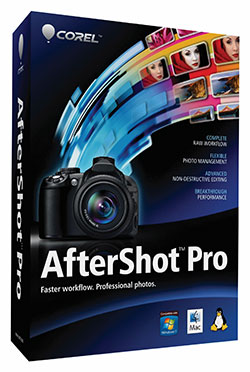Corel AfterShot Pro

 Nondestructive Photo Management Software
Nondestructive Photo Management Software
Corel's first professional photo catalog and RAW editing software, AfterShot Pro, is based on a number of technologies—Bibble Pro, Noise Ninja, and Perfectly Clear—that are widely known and respected in the photography world. It's available for Mac OS X, Windows, and Linux.
Corel AfterShot Pro is fast. Even importing 4,000 images, including the creation of thumbnails and previews, didn't take much longer than 10 minutes on an iMac i5/3.1 GHz with 12 MB of RAM. The performance does suffer a bit when you start adding a lot of corrections and adjustments to a photo, but the software stays faster than some competing products.
Interface-wise, Corel AfterShot Pro looks a lot like Bibble 5 Pro and the software borrows more than just its looks from third-party developers. Two features make Corel AfterShot Pro especially interesting: Athentech Imaging's Perfectly Clear and PictureCode's Noise Ninja.
Perfectly Clear uses patented medical imaging technology to provide photographs with optimal contrast and sharpening. Because it's a one-click feature, I was skeptical; but as an automatic adjustment early on in the workflow, it proved to be quite accurate and extremely fast.
Noise Ninja is the best noise-reduction algorithm available in the industry and users get direct access to the free version from within Corel AfterShot Pro. Noise Ninja can be registered in AfterShot Pro with all of the additional paid features becoming available, including making profiles, etc.
AfterShot Pro works with body and lens profiles. It has a database of lenses to correct for lens-associated errors; however, it's not as complete or accurate as DxO Optics Pro, which relies on lab results for lens corrections. Overall, I found Corel AfterShot Pro offers all the image-correction tools that are also available in other apps, with identical results.
With the AfterShot Pro workflow, you start with the Standard tools and then work your way down, with tools for Color, Tone, Metadata, etc. The Standard tool tab reveals a histogram, whereas the Color tab offers a combined Levels/Curves tool. Personally, I find individual Levels and Curves tools easier to use.
Corel AfterShot Pro really shines in the two management areas: It has flexible asset-management capabilities, where you can either work in the file directory, with a few restrictions, or by cataloguing images; and very complete metadata support. Also supported are versions and stacks—more flexible than in other apps—and an elaborate file-output system that allows you to rename files in myriad ways.
The program comes with a mixed bag of tools to dramatically change a photo's look.
Fill Light and Fill Range allow you to rescue photos with poor lighting, and the Straighten tool has one of the best controls I've ever seen in an image editor. Additionally, you can edit selections of an image by creating layers and drawing adjustment areas in the form of rectangles, ovals, and Bézier curves. You can also brush random areas. The Layers feature works exactly like the one in Phase One's Capture One Pro.
Less spectacular is the Healing/Clone tool, which only enables you to control the area to take samples from.
Corel AfterShot Pro supports plug-ins in the same format as the ones available for Bibble 5 Pro, but some of the Bibble plug-ins won't import into AfterShot Pro.
Company: Corel Corporation
Price: $99.99
Web: www.corel.com
Rating: 4
Hot: Fast; flexible image management; Noise Ninja; Perfectly Clear
Not: Interface needs a bit of polish
